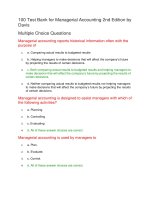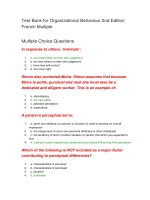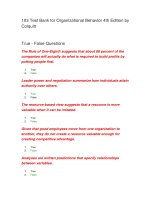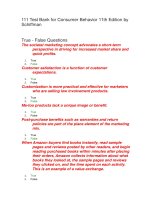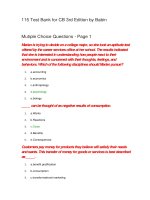105 test bank for international marketing 15th edition by cateora đề trắc nghiệm marketing
Bạn đang xem bản rút gọn của tài liệu. Xem và tải ngay bản đầy đủ của tài liệu tại đây (152.64 KB, 31 trang )
105 Test Bank for International Marketing 15th Edition
by Cateora
Multiple Choice Questions - Page 1
True - False Questions
The most effective approach to build global awareness into an
organization is to increase the diversity mix of the employee profile.
1.
True
2.
False
The difference between domestic and international marketing lies in the
different concepts of marketing.
1.
True
2.
False
John refuses to buy Japanese products because he sees this as a way of
selling out to a nation known for its aggressive behavior. John is using a
self-reference criterion to make his decision.
1.
True
2.
False
The foreign uncontrollable environment is the same as the domestic
uncontrollable environment.
1.
True
2.
False
The level of technology is an uncontrollable element for international
marketers.
1.
True
2.
False
In a domestic situation, political details and the ramifications of political
and legal events are often more transparent than they are in some foreign
countries.
1.
True
2.
False
A good illustration of an uncontrollable variable that might impact
international business is a marketing decision with respect to research.
1.
True
2.
False
A self-reference criterion is closely related to ethnocentrism.
1.
True
2.
False
Domestic foreign policy is an example of an international uncontrollable
element affecting a firm's international marketing success.
1.
True
2.
False
The uncontrollable factors a company has to deal with decreases with the
number of foreign markets in which a company operates.
1.
True
2.
False
Sam Watkins just recently ate and, therefore, feels justified in refusing
food from his Middle Eastern host. In this instance, Sam's self-reference
criterion has just saved him from making a cultural blunder.
1.
True
2.
False
The process of evaluating the uncontrollable elements in an international
marketing program involves substantial doses of cultural, political, and
economic shock.
1.
True
2.
False
Research has revealed that smaller home markets and larger production
capacities appear to favor internationalization.
1.
True
2.
False
Companies from Japan are the leading group of investors in the United
States.
1.
True
2.
False
A company at the "no direct foreign marketing" stage of international
marketing involvement does not actively cultivate customers outside
national boundaries.
1.
True
2.
False
In dealing with unfamiliar markets, marketers must be aware of the frames
of reference they are using in making their decisions.
1.
True
2.
False
The international marketer must deal with at least two levels of
uncontrollable uncertainty.
1.
True
2.
False
The international marketer is not affected by domestic competition.
1.
True
2.
False
Political and legal forces, economic climate, and competition are some of
the domestic environment controllables.
1.
True
2.
False
International marketing is the performance of business activities designed
to plan, price, promote, and direct the flow of a company's goods and
services to consumers or users in more than one nation for a profit.
1.
True
2.
False
The controllable elements can be altered in the long run and, usually, in
the short run to adjust to changing market conditions, consumer tastes,
or corporate objectives.
1.
True
2.
False
The global marketing concept views the marketplace as consisting of one
primary domestic market that is complimented by several smaller regional
markets.
1.
True
2.
False
One uncontrollable element that is generally well understood is the level
of technology.
1.
True
2.
False
Abolition of apartheid in South Africa is an example of a positive
uncontrollable element in an international marketing scenario.
1.
True
2.
False
The political and legal environment is a controllable element for
international marketers because of the ability to lobby and influence
legislation.
1.
True
2.
False
Political and legal issues a company may face abroad are mitigated by the
"alien status" of the company.
1.
True
2.
False
To avoid errors in business decisions, it is necessary to conduct a crosscultural analysis that emphasizes the need for ethnocentrism.
1.
True
2.
False
The most profound change in the orientation of a company toward
markets and associated planning activities happens at the "regular foreign
marketing" stage of the international marketing involvement.
1.
True
2.
False
Understanding one's own culture normally requires no additional study.
1.
True
2.
False
For companies today, becoming international is a luxury only some can
afford.
1.
True
2.
False
In a broad sense, the uncontrollable elements of the foreign business
environment constitute the culture.
1.
True
2.
False
Multiple Choice Questions - Page 1
Which of the following is a controllable element for an international
marketer?
1.
A. Level of technology
2.
B. Geography and infrastructure
3.
C. Channels of distribution
4.
D. Cultural forces
5.
E. Structure of distribution
Of all the events and trends affecting global business today, four stand
out as the most dynamic. Which of the following would be one of those
events?
1.
2.
A. The trend toward buying American cars in Europe.
B. The trend toward the acceptance of the free market system among developing
countries.
3.
C. The trend toward using English as the global language.
4.
D. The trend toward establishing a world currency.
5.
E. The trend toward worldwide instant communication.
The _____ and issues abroad are often amplified by the "alien status" of
the company, which increases the difficulty of properly assessing and
forecasting the dynamic international business climate.
1.
A. structure of distribution
2.
B. competitive forces
3.
C. economic forces
4.
D. political/legal forces
5.
E. level of technology
Considering the model of the international marketing task displayed in the
text, which of the following reasons demonstrates the most important
difference between the international marketer's task and that of the
domestic marketer?
1.
A. The international marketer must deal with at least two levels of uncontrollable
uncertainty instead of one.
2.
B. The level of technology and cultural forces are controllable elements for the
domestic marketer.
3.
C. The supply and distribution channels are uncontrollable elements for the
international marketer.
4.
D. The competitive structure is one of the controllable factors for an international
marketer.
5.
E. The international marketer is less concerned about geography and
infrastructure than the domestic marketer.
A political decision involving _____ would most likely have a direct effect
on a firm's international marketing success.
1.
A. domestic foreign policy
2.
B. immigration reform
3.
C. oil exploration policy
4.
D. FCC satellite regulations
5.
E. FAA airline regulations
The _____ is an uncontrollable element that can often be misread because
of the vast differences that may exist between developed and
undeveloped countries.
1.
A. structure of distribution
2.
B. competitive forces
3.
C. economic forces
4.
D. political/legal forces
5.
E. level of technology
Which of the following is an uncontrollable element for an international
marketer?
1.
A. Structure of distribution
2.
B. Promotion
3.
C. Price
4.
D. Research
5.
E. Firm characteristics
With respect to the environment in which a business operates, such
factors as competition, legal restraints, government controls, and the
weather would all be examples of what are called:
1.
A. controllable elements.
2.
B. uncontrollable elements.
3.
C. predictable elements.
4.
D. demographic elements.
5.
E. cultural elements.
_____ is the performance of business activities designed to plan, price,
promote, and direct the flow of a company's goods and services to
consumers or users in more than one nation for a profit.
1.
A. Global management
2.
B. Global business
3.
C. Marketing
4.
D. International marketing
5.
E. Global marketing concept
According to the text, the primary difference in the practice of marketing
at the domestic versus the international level is:
1.
A. the environment within which the marketing plans must be implemented.
2.
B. the cultural mix of the people working in the organization.
3.
C. the level of investment required.
4.
D. the level of management control.
5.
E. the difference in the concepts of marketing.
Which of the following is an uncontrollable factor in a domestic
environment?
1.
A. Firm characteristics
2.
B. Competitive structure
3.
C. Channels of distribution
4.
D. Price
5.
E. Promotion
_____ is the performance of business activities designed to plan, price,
promote, and direct the flow of a company's goods and services to
consumers or users in more than one nation for a profit.
1.
A. Multinational marketing
2.
B. World trade
3.
C. Corporate management
4.
D. International marketing
5.
E. Global trade
Which of the following reflects the relation between international business
and domestic business?
1.
A. Domestic economic climate does not normally impact international businesses.
2.
B. Domestic businesses find it relatively easy to manage profits in the current
scenario.
3.
C. Most domestic businesses are the result of customization efforts of international
businesses.
4.
D. The ability to invest abroad is to a large extent a function of domestic economic
vitality.
5.
E. Domestic businesses are more viable as capital tends to move toward minimum
use.
Which of the following is an example of a positive political action that
favored international marketing?
1.
A. Abolition of apartheid in South Africa
2.
B. Trade ban on Libya
3.
C. Trade embargo on Cuba
4.
D. Tariff hike for imports established by China
5.
E. Coupling human rights issues with foreign trade policy
All of the following appear as a foreign environment uncontrollable
variable in the model of the international marketing task shown in the text
EXCEPT:
1.
A. economic forces.
2.
B. competitive forces.
3.
C. channels of distribution.
4.
D. cultural forces.
5.
E. political/legal forces.
All of the following would be among the domestic marketer's controllable
environmental variables EXCEPT:
1.
A. research.
2.
B. price.
3.
C. product.
4.
D. channels of distribution.
5.
E. competitive structure.
Which of the following is NOT true of the impact of culture?
1.
A. The reaction to much of the environment's (cultural) impact on the marketer's
activities is automatic.
2.
B. In dealing with unfamiliar markets, frames of reference are unimportant in
evaluating the potential of a market.
3.
C. Judgments are derived from experience that is the result of acculturation in the
home country.
4.
D. An established frame of reference is an important factor in determining a
marketer's reaction to situations—social and even nonsocial.
5.
E. As a result of acculturation, we react in a manner acceptable to our society
without consciously thinking about it.
Which of the following is the reason why the international marketer's task
is more complicated than that of the domestic marketer?
1.
A. Because the international marketer must change his marketing goals in the
various countries of operation.
2.
B. Because the international marketer must deal with at least two levels of
uncontrollable uncertainty instead of one.
3.
C. Because technological standardization could challenge effective customization
in different markets.
4.
D. Because international trade regulations still do not allow free trade in most
markets across the globe.
5.
E. Because lack of competent skills makes effective service a major challenge.
Which of the following would be the BEST illustration of the "alien status"
found in the political and legal arena that sometimes cause problems for
international marketers as they attempt to doing business in foreign
countries?
1.
A. A company in the U.K. recently purchased Ben & Jerry's ice cream operations.
2.
B. The Indian government told Coca-Cola that it must reveal its "secret formula" if
it wished to continue doing business in India.
3.
C. Richard Branson's Virgin Cola was not widely accepted in the United States.
4.
D. French Canadians prefer French to English when conducting business in
Canada.
5.
E. British Airlines and Japan Airlines join American Airlines to form OneWorld
Alliance.
Which of the following is NOT TRUE of the impact of globalization on
domestic markets?
1.
A. Study of manufacturing companies found that multinationals of all sizes and in
all industries outperformed their strictly domestic U.S. counterparts.
2.
B. Profit levels from international ventures exceed those from domestic operations
for many multinational firms.
3.
C. On average, firm value is increased by global diversification.
4.
D. Companies with foreign operations find that foreign earnings are making an
important overall contribution to total corporate profits.
5.
E. Companies with only domestic markets have found it relatively easy to sustain
their customary rates of growth.
Current data says that foreign investments in the U.S. amount to ___.
1.
A. 23.4 trillion
2.
B. 700 million
3.
C. 30 billion
4.
D. 350 billion
5.
E. 670 billion
Which of the following is the most critical difference between domestic
marketing and international marketing?
1.
A. The environment in which marketing plans must be implemented
2.
B. The different concepts of marketing
3.
C. The change in marketing goals
4.
D. The difference in technological standards
5.
E. The change in corporate objectives
All of the following events and trends are among the four major trends
described in the chapter as having a major impact or effect on global
business EXCEPT:
1.
A. the trend toward the acceptance of the free market system among developing
countries in Latin America, Asia, and Eastern Europe.
2.
B. the rapid growth of the World Trade Organization and regional free trade areas
such as NAFTA and the European Union.
3.
C. the burgeoning impact of the Internet and other global media on the dissolution
of national borders.
4.
D. the trend toward decreasing OPEC profits as oil reserves decline in the 21st
century.
5.
E. the mandate to properly manage the resources and global environment for the
generations to come.
For an international marketer, the _____ can be altered in the long run
and, usually, in the short run to adjust to changing market conditions,
consumer tastes, or corporate objectives.
1.
A. competitive structure
2.
B. economic climate
3.
C. structure of distribution
4.
D. environmental factors
5.
E. controllable elements
Compared to the foreign environment uncontrollable variables, which of
the following elements is excluded from the domestic marketer's list of
uncontrollable variables?
1.
A. Political forces.
2.
B. Competitive structure.
3.
C. Economic climate.
4.
D. Cultural forces.
5.
E. Legal forces.
Which of the following is a possible outcome of the alien status of a
company?
1.
A. The company can be seen as an exploiter.
2.
B. The company receives preferred treatment at the hands of politicians.
3.
C. Political activists can rally support for the company.
4.
D. Local individuals are given control of management.
5.
E. The company is viewed as a platform for cultural integration.
Companies from _____ lead in foreign investment in the United States.
1.
A. Kingdom of Saudi Arabia
2.
B. Russia
3.
C. China
4.
D. United Kingdom
5.
E. Canada
Competition within the home country can have a profound effect on the
international marketer's task. Which of the following BEST illustrates this
statement?
1.
A. Boeing recently opened talks with its primary trade union to avoid a forecasted
strike.
2.
B. Microsoft and Dell have jointly invested $700 million in a new venture to
investigate high technology of the future.
3.
C. Fuji opened a $300 million plant in the U.S. and now commands a 12 percent
share of the lucrative U.S. film market.
4.
D. Several companies are still under investigation because of the Enron scandal.
5.
E. Declaration of independence by Baltic States after the collapse of the Soviet
Union.
All of the following would be considered to be controllable elements of
marketing decisions EXCEPT:
1.
A. product.
2.
B. price.
3.
C. promotion.
4.
D. research.
5.
E. government regulations.
Amy Sims has been assigned the task of preparing a marketing plan for
company for the next year's business activities. She knows that she
should begin her plan by examining the variables that she has some
control over. These controllable variables would include price, product,
channels-of-distribution, and:
1.
A. demand.
2.
B. cultural forces.
3.
C. competition.
4.
D. economic climate.
5.
E. promotion.
60 Free Test Bank for International Marketing 15th
Edition by Cateora Multiple Choice Questions - Page 2
Which of the following is true of the first two stages of international
marketing involvement—no direct foreign marketing and infrequent
foreign marketing?
1.
A. Firms may not begin internationalization at these stages
2.
B. They represent careful strategic thinking about international expansion
3.
C. They are more reactive in nature
4.
D. Firms cannot be at both the stages simultaneously
5.
E. They are sequential in the process of internationalization
Which of the following organizations seem better equipped for
internationalization?
1.
2.
A. A firm that has more than two liaison offices in foreign countries
B. A firm that has a production capacity that is much greater than home market
demand
3.
C. A firm that has more than three production facilities in the home market
4.
D. A firm that has a culturally diverse employee profile
5.
E. A firm that has experienced increased profits in home market for three
consecutive years
The primary obstacles to success in international marketing are a
person's _____ and an associated ethnocentrism.
1.
A. regionalism
2.
B. holism
3.
C. self-reference criterion
4.
D. segregation
5.
E. integration
A part of cross-cultural analysis requires understanding of one's own
culture. Why is it surprising that understanding one's own culture requires
additional study?
1.
2.
3.
4.
A. Because self-criticism is not easy to build when studying one's own culture.
B. Because much of cultural influence on market behavior is at the subconscious
level.
C. Because of the complexity of the cultural traits in one's own country.
D. Because international trade treaties mandate that managers have extensive
cultural knowledge of their own country.
5.
E. Because cultural influence on one's own market behavior is generally
undocumented.
Your _____ can prevent you from being aware that there are cultural
differences or from recognizing the importance of those differences.
1.
A. self-space
2.
B. personality
3.
C. demographic character
4.
D. self-reference criterion (SRC)
5.
E. concept of integration
Which of the following is an obvious strategy organizations should use to
build global awareness into organizations?
1.
A. Establish subsidiaries in culturally diverse countries, thus leading to intercultural communication.
2.
B. Select individual managers specifically for their demonstrated global
awareness.
3.
C. Recruit managers from other nations to increase diversity.
4.
D. Organize foreign trips for managers to improve their understanding.
5.
E. Increase mix of diversity in the employee profile of the organization.
_____ is an unconscious reference to one's own cultural values,
experiences, and knowledge as a basis for decisions.
1.
A. Regionalism
2.
B. Holism
3.
C. Self-reference criterion
4.
D. Segregation
5.
E. Xenophobia
To be globally aware, an international marketer must have all the following
EXCEPT:
1.
A. a tolerance of cultural differences.
2.
B. a knowledge of cultures.
3.
C. a knowledge of history.
4.
D. a knowledge of microeconomics.
5.
E. a knowledge of world market potential.
Which of the following will aid a manager in understanding some Latin
Americans' reluctance toward foreign investment or Chinese reluctance to
open completely to outsiders?
1.
A. A better understanding of global economic trends.
2.
B. A deeper understanding of world market potential.
3.
C. A tolerance toward cultural differences.
4.
D. An understanding of microeconomics.
5.
E. A historical perspective.
Which of the following is the most effective way to achieve organizational
global awareness?
1.
A. Establish regular awareness campaigns across the organization.
2.
B. Organize employee trips to foreign cultures to increase their sensitivity.
3.
C. Increase the diversity mix of the employee profile.
4.
D. Have a culturally diverse senior executive staff or board of directors.
5.
E. Promote social networking as a means to improve inter-cultural communication.
Which of the following is NOT a feature of firms at the internationalization
stage of regular foreign marketing?
1.
A. Permanent productive capacity devoted to the production of goods to be
marketed in foreign markets.
2.
3.
B. The primary focus of operations and production is to service foreign market
needs.
C. The firm may employ foreign or domestic overseas intermediaries.
4.
D. The firm may have its own sales force or sales subsidiaries in important foreign
markets.
5.
E. Profit expectations from foreign markets are initially seen as a bonus in addition
to regular domestic profits.
Which of the following is closely related to self-reference criterion?
1.
A. Central tendency
2.
B. Marketing myopia
3.
C. Ethnocentrism
4.
D. Multiculturalism
5.
E. Pluralism
The most effective way to control the influence of ethnocentrism and the
SRC is to:
1.
A. reduce interaction with culturally diverse audience.
2.
B. ask for feedback on every possible occasion.
3.
C. recognize their effects on our behavior.
4.
D. learn at least two foreign languages to understand the cultural differences.
5.
E. ask for second opinion in a decision-making scenario.
What is the most profound change for firms at the global marketing stage
of internationalization?
1.
A. Companies treat the world, along with home market, as one market
2.
B. Sales to foreign markets are made as and when goods become available
3.
C. Temporary surpluses are marketed in foreign markets
4.
D. Planning involves production of goods outside the home market
5.
E. Production capacity exceeds domestic demand
Which of the following BEST exemplifies the tolerance of a globally aware
manager?
1.
A. You should be familiar with the leading cultural trends in the world.
2.
B. You have to accept as your own the cultural ways of another.
3.
C. You must allow others to be different and equal.
4.
D. You must be aware of globally accepted culturally standards.
5.
E. You must have undertaken courses in cultural differences.
At which stage is the primary focus of operations and production to
service domestic market needs while the firm has permanent productive
capacity devoted to the production of goods and services to be marketed
in foreign markets?
1.
A. No direct foreign marketing
2.
B. Infrequent foreign marketing
3.
C. Regular foreign marketing
4.
D. International marketing
5.
E. Global marketing
Which of the following is true of firms at the internationalization stage of
international marketing?
1.
A. The primary focus of operations and production is to service domestic market
needs.
2.
B. As domestic demand increases and absorbs surpluses, foreign sales activity is
reduced or even withdrawn.
3.
C. Profit expectations from foreign markets are seen primarily as a bonus in
addition to regular domestic profits.
4.
D. Planning generally entails production of goods outside the home market.
5.
E. The firm treats the world, including the home market, as one market.
_____ is the conscious effort on the part of the international marketer to
anticipate the influences of both the foreign and domestic uncontrollable
factors on a marketing mix and then adjust the marketing mix to minimize
the effects.
1.
A. Standardization
2.
B. Adaptation
3.
C. Segregation
4.
D. Segmentation
5.
E. Projection
Which of the following firms/products reflects a global marketing
orientation?
1.
A. A skin-lightening cream aimed at African American women
2.
B. A company promoting Latino jazz musicals
3.
C. A firm producing high-end sailing yachts
4.
D. A fast-food company selling beef burgers
5.
E. A Japanese to English translating software
If a marketer is motivated to enter into an international marketing effort
because of temporary surpluses in the domestic market, which of the
following stages BEST characterizes the stage of international marketing
involvement for this marketer?
1.
A. Infrequent foreign marketing
2.
B. Regular foreign marketing
3.
C. No direct foreign marketing
4.
D. International marketing
5.
E. Global marketing
To avoid errors in business decisions, it is necessary to conduct a crosscultural analysis that isolates the self-reference criterion influences.
Which of the following would be the first-step to take to avoid the
aforementioned errors?
1.
A. Redefine the problem without the SRC influence.
2.
B. Solve the problem for the optimum business goal situation.
3.
C. Isolate the SRC influence in the problem and examine it carefully to see how it
complicates the problem.
4.
D. Define the business problem or goal in home-country cultural traits, habits, or
norms.
5.
E. Define the business problem or goal in foreign-country cultural traits, habits, or
norms through consultation with natives of the target country.
Which of the following is NOT one of the stages of international marketing
involvement?
1.
A. Indirect Foreign Marketing
2.
B. Infrequent Foreign Marketing
3.
C. Regular Foreign Marketing
4.
D. International Marketing
5.
E. Global Marketing
James Bright's company seeks markets all over the world and attempts to
sell products that are a result of planned production for markets in
various countries. Which of the following stages BEST characterizes the
stage of international marketing involvement for Mr. Bright's company?
1.
A. Infrequent foreign marketing
2.
B. Regular foreign marketing
3.
C. No direct foreign marketing
4.
D. International marketing
5.
E. Global marketing
For a company at the _____ stage of internationalization, market segments
are defined by income levels, usage patterns, or other factors that
frequently span countries and regions.
1.
A. domestic market extension
2.
B. multidomestic market
3.
C. global marketing
4.
D. universal marketing
5.
E. standardized marketing
Which of the following is TRUE regarding the stages of international
marketing involvement?
1.
A. A firm progresses through the stages in a linear order
2.
B. The stages do not overlap
3.
C. A firm begins its international involvement at the second stage
4.
D. A firm may be in more than one stage simultaneously
5.
E. The first stage of the process is ‘No Foreign Marketing'
There are a variety of stages in the process of becoming involved in
international marketing. Which of the following best describes the stage of
development where the company's products reach a foreign market
through no conscious effort on the part of the marketer?
1.
A. Infrequent foreign marketing
2.
B. Regular foreign marketing
3.
C. No direct foreign marketing
4.
D. International marketing
5.
E. Global marketing
Which of the following is true of ethnocentrism?
1.
A. It is the cultural binding force among a diverse employee population in an
organization.
2.
B. It is generally a problem when managers from affluent countries work with
managers and markets in less affluent countries.
3.
C. American managers have generally been uninfluenced by it, especially in the
beginning of the 21st century.
4.
D. Ethnocentrism is the causative factor behind the phenomenon of self-reference
criterion.
5.
E. Self-reference criterion is universally considered the technique to reduce or
eliminate ethnocentrism.
The Ajax Corporation has decided to enter the international marketing
arena by marketing its products on a country-by-country basis, with
separate marketing strategies for each country. The company is using
which of the following concepts to formulate its international policies and
strategies?
1.
A. Domestic market extension concept
2.
B. Multidomestic market concept
3.
C. Global marketing concept
4.
D. Universal marketing concept
5.
E. Standardized marketing concept
Which of the following organizations has a better chance of accelerating
their internationalization process?
1.
A. Firms with key managers well networked internationally
2.
B. Firms requiring global standards for employee skills
3.
C. Firms with excess production capacity than their domestic demand
4.
D. Firms using the Internet as their major communication platform
5.
E. Firms that aim at outsourcing non-core business functions
